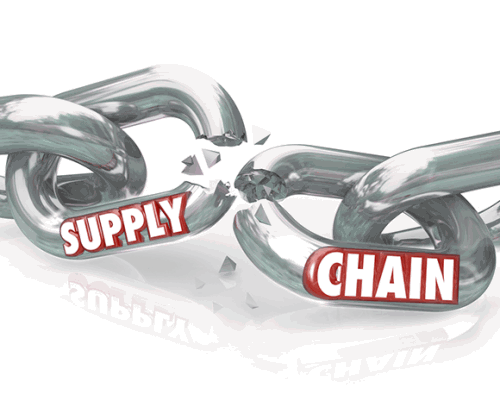

One of the cardinal rules of business is to learn from the mistakes you make during your journey, but sometimes another company’s error can be just as instructive. This is especially apparent when it comes to errors in warehouse technology.
Warehouse operations and technology have always been important, but they’ve become an increasingly indispensable part of running a 21st century business. When a warehouse breaks down, trouble almost always follows – particularly if that breakdown involves the fundamental technologies that make warehouses run.
The five businesses we’ll talk about in this article all had costly errors in their warehouse technology. Some are still cleaning up the mess that resulted, and a few never recovered. Their cautionary tales will show you what can go wrong when issues with warehousing and supply chain technology take your business unawares.

1. Asos takes a $25 million hit
British online fashion retailer Asos has had one of the most costly warehousing technology disasters in recent memory. The combined factors of a warehouse technology overhaul and trans-Atlantic supply chain issues have created a perfect storm of headaches for the company, which recently reported a big decline in Q2 sales and a prediction of $25 million to $31 million in total profits lost. Apparently, the problems stemmed from a new storage and distribution system that couldn’t keep pace with the put-away speed that the company needed, resulting in a substantial backlog of inbound inventory.
One lesson worth taking away from this disaster: Asos was classy enough not to name the software vendor it was working with. Whether this was because it didn’t want to create bad blood or because it was a client-side error, it demonstrates that the best policy is usually to resolve disputes privately and with a minimum of public finger-pointing.
2. Foxmeyer’s ERP disaster
A common theme among many of these tales of woe: implementing exciting technologies that aren’t quite ready for primetime and doubling down when things get hairy. Foxmeyer Drugs, a successful pharmaceutical distributor in the mid-90s, made big bets on highly automated warehouse systems and a new ERP system that it believed would make it the industry leader. But its new systems ran into one difficulty after another, resulting in its daily order processing numbers cratering from 420 000 to just 10 000. Foxmeyer ended up going into bankruptcy and selling out to a competitor for a fraction of its value.
One of Foxmeyer’s biggest problems was that it bid its future contracts on the savings and efficiency gains it estimated would result from its new technologies. It also failed to implement best practices of risk reduction in its ERP implementation, setting over-aggressive timeline targets and failing to involve its workers meaningfully in the process. Although there are many lessons one could take from the company’s fate, perhaps the biggest one is not to make your bets on new technology so big that they cripple your business should the project fail.
3. Sainsbury’s insists there’s no problem
In 2003, UK grocery giant Sainsbury’s was bullish on the value of automation, so much so that it decided to install an automated barcode-based fulfilment system in its Waltham Point distribution centre just outside London. Automated barcode readers and RF scanners of today are slim, effective devices in small plastic enclosures (https://www.polycase.com/), but at the time, it was a bulky and balky technology that just wasn’t quite finished. Sainsbury’s warehouses encountered tremendous difficulties thanks to these systems, but it stubbornly insisted that the system was working as intended, even as its supply chain faltered.
The system was not, in fact, working as promised, and the company went through supply chain nightmares before it admitted defeat several years later. Sainsbury’s survived, but it had to write off over £150 million in IT costs and scrap the project. The lesson should be clear: insisting that there’s no problem won’t make it go away.
4. Toys ‘R’ Us ruins Christmas
During the 1999 holiday shopping season, Toys ‘R’ Us became one of the first big retailers to lean heavily into online ordering and delivery, promising that all orders placed by 10 December would arrive by Christmas. The problem: it had both underestimated how popular its offer would be and overestimated how prepared its warehouses were to handle it. It simply didn’t have the technology or workforce to fulfil its order volume and had to send out a now-infamous email to its customers two days before Christmas telling them that their children’s toys would probably not arrive on time.
The mea culpa didn’t go over well with angry parents, and the company went through a nightmarish PR firestorm and ended up outsourcing its delivery to Amazon the next year. The example of Toys ‘R’ Us demonstrates that any marketing push should always be accompanied by a realistic appraisal of the situation and that under-promising and over-delivering is always, always preferable to the opposite.
5. Webvan grows itself over a cliff
Few remember it now, but grocery delivery service Webvan was one of the most promising startups of the 90s. It was a fast, convenient and well-stocked grocery delivery website that had a strong and growing user base who liked the service a lot. The problem: the company was still in the low-margin grocery market and it believed in itself just a little (or a lot) too much.
With all the hype around Webvan, the company’s leadership became too ambitious and built $1 billion worth of warehouse space in 1999 alone, complete with an expensive and largely untested automated system that never quite worked the way it was supposed to. But it soon learned that its customer base was growing far too slowly to support its massive capital investments and, by 2001, it was belly-up. Those wishing to avoid Webvan’s fate should remember that a startup’s hunger for growth has to be tempered with solid numbers that demonstrate demand, profitability and a path forward.
Today, we often take for granted the conveniences of scanning items with a simple handheld electronics enclosure (https://www.polycase.com/handheld-enclosures) and having them automatically logged into inventory. But as these stories demonstrate, it’s been a long and hard road to get these technologies into a working state, fraught with missteps and implosions. Thus, it’s still important that businesses should take into account the lessons of the business failures that preceded them, lest they repeat their errors.

© Technews Publishing (Pty) Ltd. | All Rights Reserved.